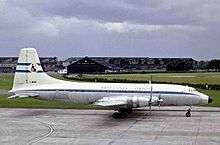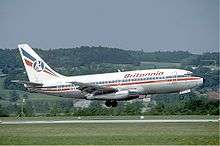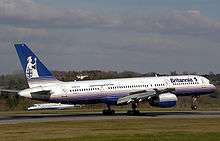Britannia Airways
 | |||||||
| |||||||
| Founded | 1 December 1961 | ||||||
|---|---|---|---|---|---|---|---|
| Ceased operations |
1 November 2005 (rebranded as Thomsonfly) | ||||||
| Operating bases |
Birmingham International Airport Gatwick Airport Glasgow International Airport London Luton Airport Manchester Airport Newcastle Airport | ||||||
| Fleet size | 47 | ||||||
| Destinations | 42 | ||||||
| Parent company | TUI | ||||||
| Headquarters | London Luton Airport, United Kingdom | ||||||
Britannia Airways was the largest charter airline in the United Kingdom. It was rebranded "Thomsonfly" in 2005. Its main bases were Gatwick, London Luton, Birmingham, Manchester, Newcastle and Glasgow. It was headquartered on the grounds of the Britannia House in Luton, Bedfordshire.[1]
History



The airline was established on 1 December 1961 by Ted Langton and started operations on 5 May 1962 as Euravia (London) flying Lockheed Constellations on inclusive tour holidays for Universal Sky Tours.
Rival charter airline Skyways, one of Britain's foremost independent airlines during the 1950s and early 1960s, had been taken over by Euravia in 1962. The Skyways takeover did not include Skyways Coach-Air, a Skyways associate, established in the early 1950s by Eric Rylands to operate low-fare coach-air services between London and several European capital cities. Following Euravia's acquisition of Skyways, Skyways Coach-Air remained independent until its successor Skyways International was taken over by Dan-Air in 1972.[2] Euravia also took on Skyways PanAm engine contract at London Heathrow using ex Skyways Avro York aircraft. One aircraft was on permanent stanby at Heathrow ready to fly a spare engine to rescue any PanAm Boeing 707 aircraft with engine problems. Rescue flights were flown as far afield as Singapore and Hong Kong. The other Yorks were used for adhoc freighting until 1965 when the last aircraft G-AGNV was flown from Luton to Staverton Gloucester to be an exhibit at the now defunct Skyfame museum. This aircraft is now in the RAF museum at RAF Cosford.
The name Britannia Airways was adopted on 16 August 1964 to coincide with re-equipping with the Bristol Britannia turboprop airliner. The last Britannia 102 was withdrawn from service in December 1970, and the airline became an all-jet operator.
In 1965 Britannia became part of Thomson, itself part of the Canadian-owned International Thomson Organisation.


Britannia began to re-equip with the Boeing 737-200 in 1968, the first European airline to operate the type. Britannia was also the first European airline to fly the Boeing 767, which it added to its fleet in the 1980s. The Boeing 767 was the first widebodied aircraft in the Britannia fleet. In August 1988 Britannia's immediate parent company, the Thomson Travel Group, purchased Horizon Travel and its airline, Orion Airways, which was integrated into Britannia.
In the 1990s, Britannia also began to operate services for Skytours and Portland Direct, themselves also part of the Thomsons Group.
In 1997 Britannia formed a wholly owned subsidiary, Britannia GmbH, based in Germany to operate long and short-haul flights from airports in Germany, Switzerland and Austria for German tour operators, but this was closed in March 2001.
At the start of 1998 the Thomson Travel Group acquired the Scandinavian holiday operation, Fritidsresor Group, and its airline Blue Scandinavia, which was renamed Britannia Nordic (now known as TUIfly Nordic).

In 2000 Thomson Travel Group and Britannia Airways were acquired by Preussag AG (TUI Group) of Germany. As part of a wider reorganisation of TUI's UK operations in September 2004 it was announced that Britannia would be rebranded as Thomsonfly. This airline's aircraft carried the Thomson colours and logo, and Thomsonfly became the trading name of Britannia Airways. On 1 November 2005 the company's legal name was changed from Britannia Airways Limited to Thomsonfly Limited. Thomsonfly later merged with First Choice Airways and was renamed Thomson Airways, retaining the previous logo and colours.
Britannia Airways was featured in the first series of the ITV fly on the wall docusoap Airline show.
Services
In January 2005, Britannia Airways operated services to the following international scheduled destinations:
- Europe
- America
- Acapulco,
- Montego Bay
- Natal
- Orlando-Now Transferred To Sanford
- Puerto Plata
- Punta Cana
- St Lucia
- Varadero
- Africa
- Asia

Fleet

At the time of rebranding, the Britannia Airways fleet consisted of the following aircraft:
| Aircraft | Total | Passengers |
|---|---|---|
| Boeing 737-300 | 9 | 148 |
| Boeing 737-500 | 4 | |
| Boeing 737-800 | 4 | 189 |
| Boeing 757-200 | 18 | 235 |
| Boeing 767-200ER | 4 | 290 |
| Boeing 767-300ER | 8 | 283 |
| Total | 47 |
From the 1980s onwards Britannia operated a solely Boeing fleet, unlike their rivals which flew Boeing aircraft alongside Airbus and McDonnell Douglas aircraft. Britannia however did at times lease Airbus aircraft.
Competitors
At the time of rebranding, Britannia was the largest charter airline in the United Kingdom, its position of market dominance being owed to the growth of Thomson Holidays. Initially its main competitor was British Airtours. The 1980s saw the growth of Monarch Airlines as a credible competitor. In the 1990s Air 2000, Airtours International Airways, First Choice Airways and Flying Colours Airlines grew as competitors. Its main competitor at the time of rebranding was Thomas Cook Airlines.
Incidents and accidents
Britannia Airways suffered two accidents whilst operating under that name (1961–2005):[3]
- On 1 September 1966, Britannia Airways Flight 105, a Bristol 175 Britannia, crashed into high ground on the approach to landing at Ljubljana, Slovenia due to pilot error after a flight from Luton, England. Of the 117 onboard 98 died.[4][5]
- On 14 September 1999, Britannia Airways Flight 226A, a Boeing 757-204, crashed on its second attempt of landing in heavy rain and poor weather conditions. Of the 236 passengers and 9 crew on board, two were seriously injured and 41 sustained minor injuries. One of the passengers who had apparently sustained only minor injuries died five days later of unsuspected internal injuries. The flight was an international charter between Cardiff, Wales, UK and Girona Airport, Spain.
References
- ↑ "World Airline Directory." Flight International. 28 March - 3 April 2000. 60." Retrieved on 26 June 2010.
- ↑ The Spirit of Dan-Air, Simons, G.M., GMS Enterprises, Peterborough, 1993, pp. 77/8
- ↑ Britannia Airways incidents and accidents
- ↑ Britannia Airways Flight 105
- ↑ "Altimeter Setting in Doubt at Ljubljana - Jugoslav report criticises crew and airline" Flight International 12 September 1968, p.397 (PDF file), continued, p.398
Bibliography
- Cuthbert, Geoffrey: Flying to the Sun: Quarter Century of Britannia Airways; London, UK: Hodder & Stoughton 1987, ISBN 978-0-340-41020-2
- Merton-Jones, A.C. : British Independent Airlines Since 1946; Volume One; Liverpool, UK: Merseyside Aviation Society & LAAS 1976 ISBN 978-0-902420-07-6.
- Simons, Graham M. (1993). The Spirit of Dan-Air. Peterborough, UK: GMS Enterprises. ISBN 978-1-870384-20-9.
See also
- Thomsonfly
- Thomson Airways
- TUIfly Nordic (formerly Britannia Airways AB)
- TUI Airlines
External links
| Wikimedia Commons has media related to Britannia Airways. |
- Britannia Airways (Archive)
- Britannia Airways (Archive)
- Fleet
- Photos of Britannia Airways aircraft